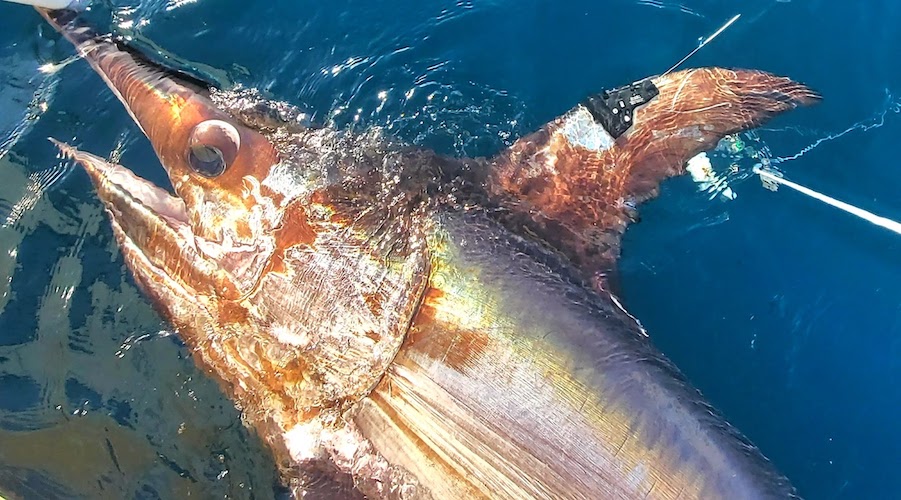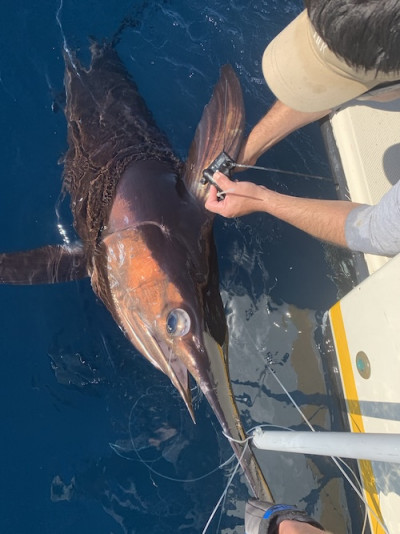This is the first in a yearlong series of stories showcasing the research that the Ocean Protection Council supported in partnership with California Sea Grant, with funding from Proposition 84.
Swordfish has long been a culinary star. Its firm flesh can stand up to preparations that flakier, more delicate fish could never handle — thrown atop a grill as a steak, for example. But in California, the fishery is not without controversy. The gillnets commercial fishermen use to catch swordfish have a high rate of bycatch and are known to entangle marine mammals and endangered sea turtles.
A federal law phasing out the use of gillnets is now on the books, but that leaves fishermen with few options. Fortunately, researchers at the Pfleger Institute of Environmental Research (PIER), have been working for more than a decade to fix the problem, developing new gear that drastically reduces bycatch incidents.
Deep-set buoy gear targets swordfish swimming between 800 and 1,200 feet below the ocean surface, where few other large species swim, reducing the risk of bycatch. Trials have shown bycatch has dipped to less than 5 percent while using the new gear, which was authorized in 2023 for use in California’s waters. It’s now one of the primary ways California’s commercial fishermen sustainably harvest swordfish.

But gear type isn’t the only concern when it comes to the region’s swordfish. The fishery itself is considered data-poor. Historically, most of the information collected about swordfish populations has come from fishing operations, which don’t track whether the fish cross internationally agreed-upon fisheries boundaries. That lack of information has made it difficult to know if current harvesting rates are sustainable.
Chugey Sepulveda, the director of research and education at PIER, led the team that developed the deep-set buoy gear. PIER’s researchers spent several years testing the gear off the California coast, from San Francisco south to the Mexican border — work that provided an opportunity to tag healthy individuals that are ideal for migration studies. Those tagging efforts offered an unprecedented opportunity to address unanswered questions about swordfish movements throughout the Pacific.
Using Ocean Protection Council funds, and supported by California Sea Grant, PIER’s research team deployed over 150 electronic tags on over 90 different swordfish. Researchers from PIER also worked with two electronic tag manufacturers, Lotek Wireless Ltd and Wildlife Computers, to optimize tag designs specifically for swordfish, a collaboration that has resulted in similar tagging efforts in other ocean basins. Each time a tagged swordfish surfaces to bask, the tags send its geographic position back to researchers. The team also collaborated with the Alvarado Bremer Laboratory at Texas A&M at Galveston to provide researchers with additional genetic evidence that will further the understanding of how swordfish utilize the Pacific and whether existing stock boundaries are accurate.

Researchers already knew that swordfish forage along the California coastline between July and January, until, come winter, mature individuals make their way to warmer tropical waters to spawn. Now, with nearly 2.5 years of tracking, researchers have built up an impressive dataset set for swordfish — one that provides extensive details about their migration routes and movements throughout the north Pacific. Sepulveda and his team found that individual fish traveled thousands of miles each season: as far south as the equator or as far west as the Island of Kona, Hawaii. But despite the great distances traversed, the fish stayed loyal to their favored foraging grounds in California, returning to the same general locations year after year.
International management protocols assumed Pacific swordfish existed in two separate stocks, but the new data suggested that California swordfish do not stay within the boundaries as currently drawn. Southern California swordfish, for example, spent significant time in both the Eastern Pacific and Western and Central Pacific management units. This, along with data from previous PIER tagging efforts, including those funded through the National Oceanic and Atmospheric Administration’s Saltonstall Kennedy Program, prompted the International Scientific Committee for Tuna and Tuna-like species in the North Pacific Ocean and the Inter-American Tropical Tuna Commission — the two organizations that manage swordfish stocks in the region — to modify the boundary designations in the North Pacific in 2023.
“This study is a good example of how electronic tagging and migration data can be used to improve management of shared resources in the Pacific,” Sepulveda says.
About California Sea Grant
NOAA’s California Sea Grant College Program funds marine research, education and outreach throughout California. Headquartered at Scripps Institution of Oceanography at the University of California San Diego, California Sea Grant is one of 34 Sea Grant programs in the National Oceanic and Atmospheric Administration (NOAA), U.S. Department of Commerce.